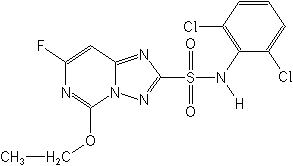|
Return to Diclosulam
Index Page
ACTIVITY: Herbicide
(triazolopyrimidine)
Structure:

Adverse
Effects:
Body
Weight Decrease
Kidney
Liver
As of
February 17, 2005, this herbicide is permitted in
or on 2 food commodities
in the United States - see list at bottom of page.
|
Body
Weight Decrease (click
on for all fluorinated pesticides)
-- Chronic toxicity.
EPA has established a chronic RfD of 0.05 mg/ kg/day NOAEL equals
5 mg/kg/day; Uncertainty Factor (UF) = 100) for use in assessing
chronic dietary risk. This chronic RfD is based on the 2- year
combined chronic feeding/carcinogenicity study in rats, in which
the following effects were observed at the lowest observable adverse
effect level (LOAEL) of 100 mg/kg/day in both sexes: statistically
significant decreases in body weight gain, changes
in renal tubule and kidney function parameters, and increased
incidence of male kidney pelvic epithelium hyperplasia.
-- Short- and intermediate-term toxicity. The toxicological endpoint
for short- and intermediate-term inhalation risk assessments is
a maternal/developmental no observable adverse effect level (NOAEL)
of 10 milligrams/kilograms/day (mg/kg/day) based on the dose-dependent
increased abortions, and decreased maternal
body weight gain, food consumption, and fecal output in
the rabbit oral developmental study.
Ref: Federal Register: March 8, 2000 (Volume
65, Number 46)] [Rules and Regulations] [Page 12129-12134]. Diclosulam;
Pesticide Tolerance. Final Rule.
http://www.fluorideaction.org/pesticides/diclosulam.fr.march8.2000.htm
Kidney
(click
on for all fluorinated pesticides)
Based on oral feeding
studies, the primary target organs are the
liver and kidney. In a subchronic rat feeding study, the
primary target organ is the liver including increased relative
organ weight, hepatocellular hypertrophy, and slight multifocal
necrosis. Decreased body weight and kidney
lesions were also noted. Liver effects were also noted
in a subchronic dog study and included increased relative liver
weight, centrilobular hepatocellular changes, and hepatocellular
necrosis accompanied by elevated ALP, AST, and ALT... In
a chronic toxicity/oncogenicity study in the rat, the kidney is
identified as a target organ... The
kidney was also a target organ in a mouse carcinogenicity study.
Among the observed kidney effects were reduced vacuolization
in the tubular epithelium, lower absolute and relative kidney
weights, and focal dilatation with hyperplasia of the epithelial
lining in the cortical tubules.
Ref: Federal Register: March 8, 2000 (Volume
65, Number 46)] [Rules and Regulations] [Page 12129-12134]. Diclosulam;
Pesticide Tolerance. Final Rule.
http://www.fluorideaction.org/pesticides/diclosulam.fr.march8.2000.htm
Liver
(click on for all fluorinated
pesticides)
Based on oral feeding
studies, the primary target organs are the
liver and kidney. In a subchronic rat feeding study, the
primary target organ is the liver
including increased relative organ weight, hepatocellular
hypertrophy, and slight multifocal necrosis. Decreased
body weight and kidney lesions were also noted. Liver
effects were also noted in a subchronic dog study and included
increased relative liver weight,
centrilobular hepatocellular changes, and hepatocellular necrosis
accompanied by elevated ALP, AST, and ALT.
Ref: Federal Register. March 8, 2000. Diclosulam;
Pesticide Tolerance. Final Rule.
http://www.fluoridealert.org/pesticides/Diclosulam.FR.March8.2000.htm
A
February
17, 2005,
check at the Code
of Federal Regulations for Diclosulam: this herbicide is
permitted in or on 2 food
commodities in the United States.
The
following list identifies these crops for which EPA has set
pesticide tolerances.
|
| [Code
of Federal Regulations]
[Title 40, Volume 22]
[Revised as of July 1, 2004]
From the U.S. Government Printing Office via GPO Access
[CITE: 40CFR180.543]
[Page 497]
TITLE 40--PROTECTION OF ENVIRONMENT
CHAPTER I--ENVIRONMENTAL PROTECTION AGENCY (CONTINUED)
PART 180_TOLERANCES AND EXEMPTIONS FROM TOLERANCES FOR PESTICIDE
CHEMICALS
IN FOOD--Table of Contents
Subpart C_Specific Tolerances
Sec. 180.543 Diclosulam; tolerances
for residues.
(a) General. Tolerances are established for residues of the
herbicide diclosulam [N-(2,6-dichlorophenyl)-5-ethoxy-7-fluoro[1,2,4]
triazolo[1,5-c]pyrimidine-2-sulfonamide] in or on the following
raw
agricultural commodities as follows: |
| Commodity |
Parts
per million |
| Peanut
nutmeat |
0.020 |
| Soybean,
seed |
0.020 |
| (b)
Section 18 emergency exemptions. [Reserved]
(c) Tolerances with regional registrations. [Reserved]
(d) Indirect or inadvertent residues. [Reserved] |
|

